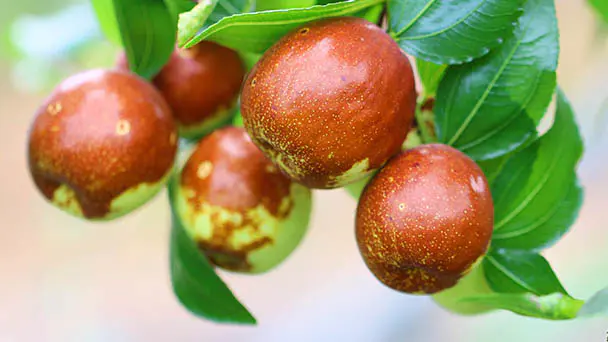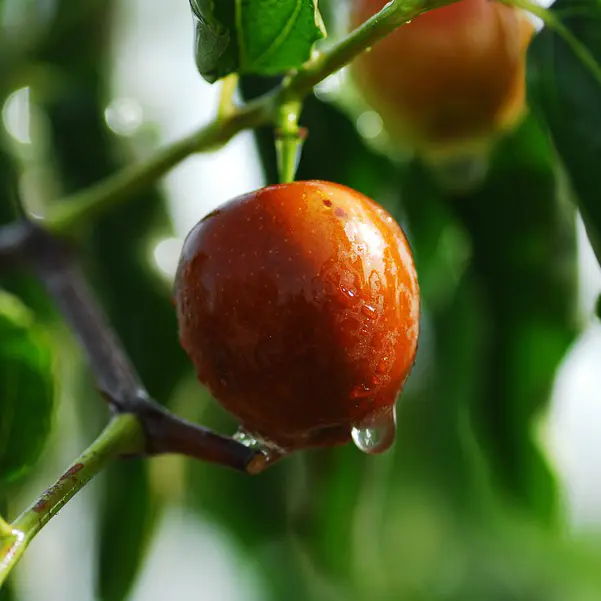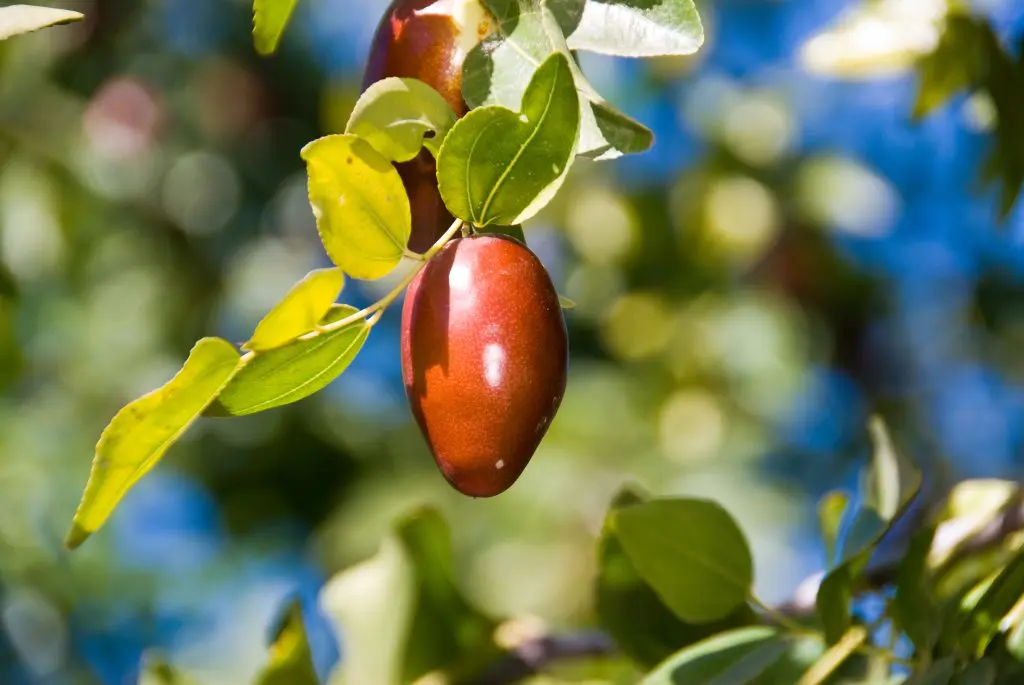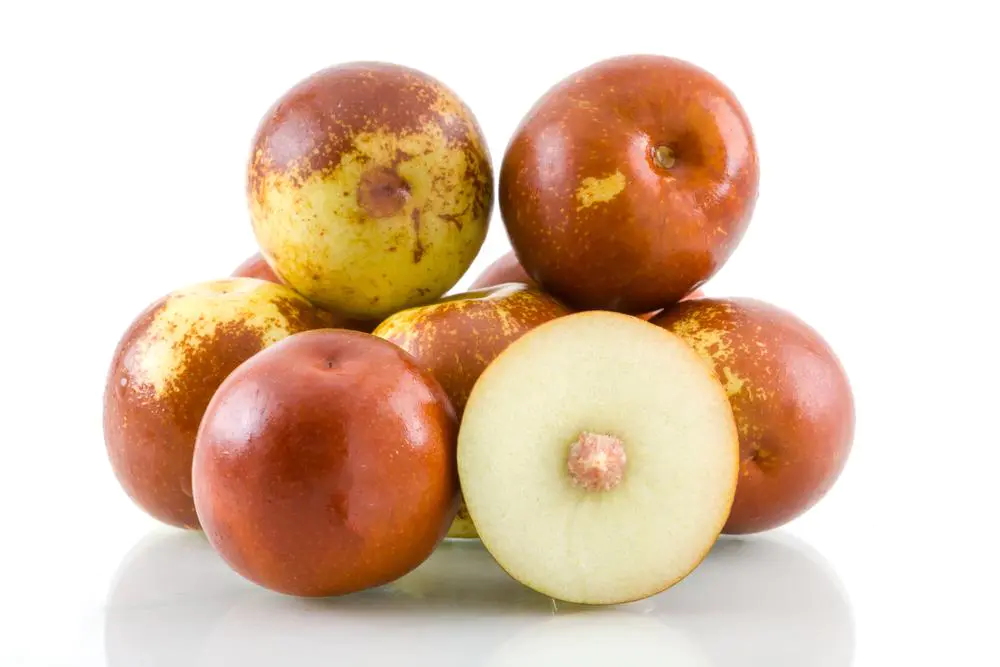Jujube Tree (Ziziphus Mauritiana) Grow and Care Guide
Written by Ivy
Nov 13 2021

Jujube tree (Ziziphus Mauritiana) is an excellent late maturing fresh food variety of spinless Jujube tree. In recent years, the market is in short supply and has high economic value. Vigorously developing Jujube tree can obtain high economic, ecological and social benefits. Let's take a look at Jujube tree propagation and maintenance!

Jujube tree sprinkler irrigation is divided into fixed sprinkler irrigation and mobile sprinkler irrigation. Water is sprayed into the orchard through pipes and nozzles through mechanical pressure. The Jujube tree watering method has the advantages of water saving and labor saving. It can also be combined with spraying and foliar fertilization. It is also suitable for Jujube tree gardens with uneven ground. At the same time, we can also adjust the microclimate and improve the air humidity of Jujube tree, which is conducive to fruit setting.
The effect of light on the growth of Jujube tree is common in production. As far as a tree is concerned, Jujube tree has more fruit at the top, good quality, less fruit in the inner bore and lower part, and poor quality. Therefore, in production, in addition to reasonable close planting, we should also shape a good Jujube tree structure through reasonable pruning in winter and summer, improve the lighting conditions of each part, and achieve high yield and high quality.
Soil moisture can directly affect the water balance and organ growth and development of Jujube tree. Jujube tree seedlings wilt temporarily when the water content of 30 cm soil layer is 5%, wilt when the water content is 3%, excessive water and poor soil permeability will cause rotten roots and even death.
In addition to the base fertilizer before planting, Jujube tree needs to be topcoated at least once at the end of May, the end of June, the beginning of July and the beginning of August of the year. It is also mainly organic fertilizer with phosphorus fertilizer as the auxiliary. It is recommended to apply organic fertilizer in autumn by furrow application.
We fertilize Jujube tree in dry weather, which can be combined with watering, which is conducive to faster nutrient absorption by roots. Fertilizer is indispensable during the growth of Jujube tree.
Before Jujube tree blooms, we also need to apply an appropriate amount of urea, a certain amount of potassium fertilizer and diammonium phosphate during fruit bearing, and a certain amount of farm fertilizer before and after defoliation.
If there are dense, crossed and overlapping branches on the Jujube tree, these branches should be removed from the base of the fruit tree to improve the light intensity and ventilation conditions in the Jujube tree canopy. The drooping and thin branches of Jujube tree shall be retracted to control its growth range. The extended branches of winter jujube fruit trees should be cut short to stimulate the germination of main buds and form new jujube heads. We should pay attention to the removal of the first secondary branch under the cut. For branches with unreasonable angle and orientation, we can turn branches from the base of Jujube tree and hang them down, and fix the branches with ropes.
If Jujube tree seedlings want to be potted or turned over for soil replacement during growth, they need to be transplanted. The best time for Jujube tree to change pots is about March to may in spring. During this time period, Jujube tree's roots can easily adapt to the new soil and survive in the new pot soil.
Generally, Jujube tree can grow healthily and luxuriantly under the environment of 18 ~ 25 ℃, making it the most tenacious period of growth. In spring, March ~ May is better suitable for transplanting, so that its roots can adapt to the new soil faster. However, spring is a rainy season, and it is easy to rot roots after transplanting, so it is best to carry out Jujube tree Jujube tree in sunny days and sunshine.
In addition to screening during seed selection and planting in spring as far as possible, we also need to be prepared at all times in the later stage of planting, regularly patrol the orchard, and take measures to find out early and prevent in time.
① Root Cutting Method:
The root segments with a diameter of 1 ~ 3cm and a length of 10 ~ 20cm are intercepted in spring and autumn every year, obliquely inserted into the open seedling border, and the top is covered with soil of 5cm. Jujube tree propagation from cutting matrix we'd better use loose and fertile sandy loam, and we must grasp the dry humidity of the soil. Often water and moisturize, and pay attention to shade at high temperature. The seedling rate is high and the seedlings grow strong.
② Branch Insertion Method:
From June to early August, we can select the new shoots of Jujube tree in the current year (collected when the new shoots are semi lignified) as cuttings. Due to rich nutrition and short internodes, it is conducive to wound healing and hair roots. The new shoots were soaked in 800 fold carbendazim aqueous solution for 5 minutes, dipped in indole butyric acid 500 ppm or ABT Rooting Powder aqueous solution for 5 ~ 10 seconds, and then inserted into the prepared matrix. Under the condition of intermittent spraying in plastic shed, the survival rate of Jujube tree cuttings can reach over 90%. After fully healing and rooting, it can be moved to the open nursery, but pay attention to shading for half a month to gradually adapt to the environment. The dry humidity should be appropriate. In case of drought, spray water in time to avoid affecting normal growth. Before overwintering, fill enough antifreeze water and cultivate soil at the seedling base. We'd better cover it with a thin layer of straw to keep warm and moisturize. After transplantation, the growth of seedlings in the current year is small, but the height in the second year can reach 50 ~ 60 cm. The roots are strong and well developed.
Jujube tree Quick InfoWhen to Plant Jujube treeWhen does Jujube tree Bloom & HarvestJujube tree Care in DetailJujube tree WateringJujube tree SoilJujube tree LightJujube tree TemperatureJujube tree HumidityJujube tree FertilizerJujube tree PruningJujube tree RepottingJujube tree Pest & Disease ControlJujube tree PropagationJujube tree Propagation from CuttingJujube tree Propagation from GraftingJujube tree Benefits1. Antidote2. Regulating immunity3. Protect the liver
Jujube tree Quick Info
| Botanical/Scientific Name | Ziziphus Mauritiana |
| Common Name | Ziziphus Jujuba |
| When to Grow/Bloom/Harvest | Plant jujube trees in late spring/Bloom in early summer/Jujubes will start producing in 3 or 4 years |
| Uses | Treat conditions like insomnia and anxiety |
| Origin | China |
| Light Care | Full sun |
| Soil Care | Sandy,well-drained soil |
| Temperature Care | Tolerate winter lows down to -20 degrees F. (-29 C.) |
| Humidity Care | Warm, dry climates |
| Watering | 2 – 3 times per week during the hot summer season |
| Pruning Care | Prune the tree in late fall or early winter |
| Fertilizer Care | 10-10-10 at two-month intervals |
| Propagation | Grafting two genotypes or cultivars together |
| Toxic | Non toxic |
| Flower Color | Yellowish-light-green-colored flowers |

When to Plant Jujube tree
Jujube tree can be planted in autumn or spring. Autumn planting is carried out after defoliation and before winter closure, and spring planting is carried out after soil thawing and before germination. Jujube tree is planted from falling leaves in autumn to the time before bud germination in the next spring. It can be planted as long as the soil is not frozen. Jujube tree has a high survival rate when buds sprout in spring.When does Jujube tree Bloom & Harvest
Jujube trees generally begin to blossom in early June, with full flowering in mid June, fruiting from late June to early July, young fruit in July, fruit expansion in August, fruit coloring in September and fruit maturity in October.Jujube tree Care in Detail
Jujube tree Watering
When we water Jujube tree, we can use the water pipe to deliver the water to the tree tray, and then drip it slowly around the root system in the form of drip, so as to supplement soil moisture in the form of infiltration. Drip irrigation can save water, can be combined with topdressing, can supply water to rhizosphere soil evenly and stably, keep soil moist and well ventilated, and is conducive to root growth and water absorption.Jujube tree sprinkler irrigation is divided into fixed sprinkler irrigation and mobile sprinkler irrigation. Water is sprayed into the orchard through pipes and nozzles through mechanical pressure. The Jujube tree watering method has the advantages of water saving and labor saving. It can also be combined with spraying and foliar fertilization. It is also suitable for Jujube tree gardens with uneven ground. At the same time, we can also adjust the microclimate and improve the air humidity of Jujube tree, which is conducive to fruit setting.
Jujube tree Soil
Soil is the supply of water and mineral elements required for the growth and development of Jujube tree. Soil texture, soil layer thickness, air permeability, pH (pH value), water and organic matter have a direct impact on the growth and development of Jujube tree. Jujube tree does not have strict requirements for soil, which is resistant to saline alkali and barren soil. It can grow normally in the range of soil pH 5.5 ~ 8.2, and can endure when the soil salt content is 0.4%, but especially the winter Jujube tree growing in fertile sandy loam has tall crown, deep and wide root system, strong growth, high yield and high and stable yield; It grows in sandy soil or gravelly soil with low fertility, has poor water and fertilizer retention, weak tree potential and low yield. Jujube tree shall be planted on the loam with deep soil layer as far as possible. For Jujube tree growing under poor soil conditions, we shall strengthen management, improve soil fertility, improve soil fertilizer supply, water supply capacity and air permeability, meet Jujube tree's demand for fertilizer and water, and achieve the goal of high quality and stable yield.Jujube tree Light
Jujube tree is highly photophile, and its photosynthesis is directly affected by the illuminance and sunshine length, thus affecting its growth and fruit. Appropriate illumination can not only promote the growth and differentiation of Jujube tree cells, but also control cell division and elongation, which is conducive to the accumulation and normal growth of dry matter in the tree. The quantity and quality of flower bud formation decrease with the decrease of illumination. Insufficient illumination affects fruit development and causes fruit drop. Insufficient light on Jujube tree will also affect root growth.The effect of light on the growth of Jujube tree is common in production. As far as a tree is concerned, Jujube tree has more fruit at the top, good quality, less fruit in the inner bore and lower part, and poor quality. Therefore, in production, in addition to reasonable close planting, we should also shape a good Jujube tree structure through reasonable pruning in winter and summer, improve the lighting conditions of each part, and achieve high yield and high quality.
Jujube tree Temperature
Temperature is one of the main factors affecting the growth and development of Jujube tree, which directly affects the distribution of winter jujube. Jujube tree is a thermophilic tree species. Its growth and development requires higher temperature, which is characterized by late germination and early defoliation. When the temperature rises to 13 ~ 15 ℃ in spring, Jujube tree jujube buds begin to germinate, branch, leaf and flower bud differentiation at 17 ~ 18 ℃, bud appears at 19 ℃, the daily average temperature reaches about 20 ℃ and enters the initial flowering period, and 22 ~ 25 ℃ enters the full flowering period.
Jujube tree Humidity
Jujube tree has a wide range of adaptability to humidity. It is distributed in the area with annual precipitation of 100 ~ 1200 mm, and the precipitation of 400 ~ 700 mm is more suitable. Jujube tree is drought resistant and waterlogging resistant. It grows and bears fruit normally in areas with annual precipitation of 100 ~ 1160 mm. Jujube garden will not die from waterlogging for more than a month.Soil moisture can directly affect the water balance and organ growth and development of Jujube tree. Jujube tree seedlings wilt temporarily when the water content of 30 cm soil layer is 5%, wilt when the water content is 3%, excessive water and poor soil permeability will cause rotten roots and even death.
Jujube tree Fertilizer
Jujube tree does not have high requirements for water and fertilizer. Jujube trees need to be watered thoroughly at least once before germination, flowering, young fruit expansion and before the arrival of winter. In the season with more rainfall, we should also pay attention to timely drainage. In dry weather, appropriate watering can be carried out according to the soil conditions.In addition to the base fertilizer before planting, Jujube tree needs to be topcoated at least once at the end of May, the end of June, the beginning of July and the beginning of August of the year. It is also mainly organic fertilizer with phosphorus fertilizer as the auxiliary. It is recommended to apply organic fertilizer in autumn by furrow application.
We fertilize Jujube tree in dry weather, which can be combined with watering, which is conducive to faster nutrient absorption by roots. Fertilizer is indispensable during the growth of Jujube tree.
Before Jujube tree blooms, we also need to apply an appropriate amount of urea, a certain amount of potassium fertilizer and diammonium phosphate during fruit bearing, and a certain amount of farm fertilizer before and after defoliation.
Jujube tree Pruning
Like other fruit trees, Jujube tree also needs pruning, and it also has its own shaping and pruning methods. The pruning of Jujube tree is usually carried out after the leaves of fruit trees fall and before the leaf buds germinate. If you want Jujube tree to bear rich fruits in the second year, you need to pay great attention to pruning.If there are dense, crossed and overlapping branches on the Jujube tree, these branches should be removed from the base of the fruit tree to improve the light intensity and ventilation conditions in the Jujube tree canopy. The drooping and thin branches of Jujube tree shall be retracted to control its growth range. The extended branches of winter jujube fruit trees should be cut short to stimulate the germination of main buds and form new jujube heads. We should pay attention to the removal of the first secondary branch under the cut. For branches with unreasonable angle and orientation, we can turn branches from the base of Jujube tree and hang them down, and fix the branches with ropes.
Jujube tree Repotting
Jujube tree needs to change its pots when it is young, turning pots and changing soil. Generally, it is best to repot it from March to may in spring. The temperature in this period is better between 18 ~ 25 ℃. The roots of Jujube tree can better stretch in the new pot soil and quickly adapt to the new soil. However, it is rainy in spring. It is best to transplant it when the weather is sunny.If Jujube tree seedlings want to be potted or turned over for soil replacement during growth, they need to be transplanted. The best time for Jujube tree to change pots is about March to may in spring. During this time period, Jujube tree's roots can easily adapt to the new soil and survive in the new pot soil.
Generally, Jujube tree can grow healthily and luxuriantly under the environment of 18 ~ 25 ℃, making it the most tenacious period of growth. In spring, March ~ May is better suitable for transplanting, so that its roots can adapt to the new soil faster. However, spring is a rainy season, and it is easy to rot roots after transplanting, so it is best to carry out Jujube tree Jujube tree in sunny days and sunshine.
Jujube tree Pest & Disease Control
Jujube tree has few pests and many common diseases, including black spot, fruit shrinkage disease, rotten fruit disease, fruit cracking disease and soft rot. generally, Jujube tree cultivated in winter has a relatively high probability of diseases and pests. In summer, we should pay attention to the occurrence of black spot, and the incidence of soft rot is high in the period of results.In addition to screening during seed selection and planting in spring as far as possible, we also need to be prepared at all times in the later stage of planting, regularly patrol the orchard, and take measures to find out early and prevent in time.
Jujube tree Propagation
Jujube tree Propagation from Cutting
Jujube tree propagation from cutting can be divided into root cutting and branch cutting. It is difficult for branches to take root and the survival rate is not high; Rooting is more commonly used.① Root Cutting Method:
The root segments with a diameter of 1 ~ 3cm and a length of 10 ~ 20cm are intercepted in spring and autumn every year, obliquely inserted into the open seedling border, and the top is covered with soil of 5cm. Jujube tree propagation from cutting matrix we'd better use loose and fertile sandy loam, and we must grasp the dry humidity of the soil. Often water and moisturize, and pay attention to shade at high temperature. The seedling rate is high and the seedlings grow strong.
② Branch Insertion Method:
From June to early August, we can select the new shoots of Jujube tree in the current year (collected when the new shoots are semi lignified) as cuttings. Due to rich nutrition and short internodes, it is conducive to wound healing and hair roots. The new shoots were soaked in 800 fold carbendazim aqueous solution for 5 minutes, dipped in indole butyric acid 500 ppm or ABT Rooting Powder aqueous solution for 5 ~ 10 seconds, and then inserted into the prepared matrix. Under the condition of intermittent spraying in plastic shed, the survival rate of Jujube tree cuttings can reach over 90%. After fully healing and rooting, it can be moved to the open nursery, but pay attention to shading for half a month to gradually adapt to the environment. The dry humidity should be appropriate. In case of drought, spray water in time to avoid affecting normal growth. Before overwintering, fill enough antifreeze water and cultivate soil at the seedling base. We'd better cover it with a thin layer of straw to keep warm and moisturize. After transplantation, the growth of seedlings in the current year is small, but the height in the second year can reach 50 ~ 60 cm. The roots are strong and well developed.
Jujube tree Propagation from Grafting
Jujube tree propagation from grafting can increase the yield of fruit, because it can keep the golden ear fresh enough and have enough water without water loss. After Jujube tree propagation from grafting is completed, we must tightly bind the marriage interface with grafting film to improve its growth speed. After that, we must bury the seedlings in soil and water them appropriately to keep Jujube tree at a certain humidity. In fact, the way of grafting is also very important in grafting and reproduction. If the marriage interface is not tied tightly, Grafting failure will occur, resulting in dehydration of the original Jujube tree.
Jujube tree Benefits
1. Antidote
Rich in fructose and vitamin C is jujube's secret to help relieve alcohol. Since ancient times, fructose and vitamin C have been used as antidotes. Moreover, some astringent ingredients in jujube can decompose alcohol and help people wake up from alcohol.2. Regulating immunity
Jujube can enhance myocardial contractility, protect coronary artery, reduce cholesterol and inhibit cancer cell proliferation, because jujube is rich in cyclic adenosine monophosphate and other substances, which is an important physiologically active substance and participates in a variety of physiological activities in human body.3. Protect the liver
Jujube is rich in sugars, vitamin C and cyclic adenosine monophosphate, which can reduce the damage of various chemicals to the liver, promote the synthesis of protein in the liver, increase the content of serum albumin, adjust the ratio of albumin to globulin, and reduce the level of serum alanine aminotransferase.Latest Updated
- Benefits of Bugleweed - 7 Science-backed Health Benefits
- Bugleweed Dangers & Side Effects - Is It Poisonous?
- How to Plant Evergreen Trees - What You Should Know
- When to Plant Evergreens - Grow Guide for Evergreen Trees
- 12 Wonderful Evergreen Shrubs for Your Garden
- 12 Popular Evergreen Plants with Pictures for Beginners
- When And How To Prune A Lilac Bush Like a Pro
- How to Grow & Care for Lilac Vine (Hardenbergia Violacea)
- Japanese Lilac Tree (Syringa Reticulata) Care & Propagation Guide
- Shumard Oak Pros and Cons - What to Know
Popular Articles
- Winter maintenance of Antirrhinum Majus
- How to Grow Terminalia Mantaly Tree
- How to Grow and Care for Crossostephium Chinense
- How to grow Antirrhinum Majus in spring
- Peristeria Elata (Dove Orchid) Profile: Info & Care Guide
- Underwatered Snake Plant (Sansevieria Trifasciata) - Signs And How To Fix
- How to Care for Brazilian Jasmine Plant (Mandevilla Sanderi)
- How to Grow & Care for Graptopetalum Purple Delight in Summer
- Rosa Chinensis (China Rose): Plant Growing & Care Tips
- How to Care for Baby Sun Rose (Aptenia Cordifolia)